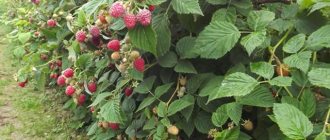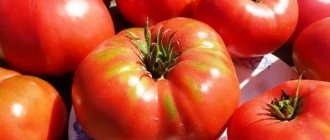In no way do I want to denigrate domestic varieties. But sometimes one gets the impression that some are simply “unfinished,” little time was devoted to selection, and the main task was to come up with big names. And why do dozens of years pass since the release of new raspberries for sale, and people have neither a clear opinion nor objective assessments? Why does the State Register indicate one data, but in practice it turns out completely different? With the indicated good frost resistance, the plants freeze out; with the stated high keeping quality and transportability of the berries, in real life they crumple, flow, and the like. And why does a gardener, in order to view complete data on plants patented in our country, need to either buy a paid database or be a real hacker? But there are truly worthy specimens that delight their owners year after year and give reason to admire themselves. But is it really possible to be proud of the Pride of Russia? More about this in our article below.
Description of raspberries Pride of Russia
Raspberry Pride of Russia was bred in 1996 by Moscow breeders by crossing two varieties - Stolichnaya and Shtambovy-20. The first selected seedling received code T-4. The creator of the hybrid is Viktor Valeryanovich Kichina.
A medium-early ripening variety, the first harvest is ready for harvest in early July. The last ripe berries appear on the bush by the end of August. For central Russia, Pride of Russia is considered one of the most productive.
Pride of Russia raspberries are large and elongated, making them look very appetizing
The raspberry bush looks compact: it is short, the maximum height is 1.5 m. Sometimes this value can reach 1.8 m. Each branch forms 8–12 shoots. The root system creates 5–7 offspring. In the first year, the branches of the variety are strong, with a clearly visible rosette of pubescent leaves at the top. They have no wax coating and no thorns. With the onset of cold weather, the shoots turn light brown.
Raspberry leaves are large and bright green. Fruit branches grow in their axils in the second year of the bush’s life. Each of them can bring up to 25 large and elongated conical berries (with a blunt tip). The weight of one fruit is from 12 to 20 g, but there are also specimens weighing 40 g. The pulp is dense, the surface of the berry looks lumpy. Ripe fruits acquire a light red color and become velvety to the touch.
Raspberry productivity reaches an average of 30–40 c/ha. With intensive care, this figure can be increased to 17–20 t/ha.
The drupe is tightly knit and dry. Even when fully ripe, it does not crumble. The seeds do not reach large sizes, remaining small and imperceptible to taste. When harvested, the fruits do not lose their shape and come off well. The berries at the point of detachment remain dry, which has a beneficial effect on the transportability of the crop. The fruits do not fall apart into separate units, do not get wet or flow.
Double berries may appear on the Pride of Russia bush. This is the result of exposure to specific weather conditions.
Video: Review of large-fruited variety
Reviews from gardeners
The variety is good for everyone: thornless, the berry is large, it comes off beautifully, it lies, “doesn’t leak”, it looks beautiful. But sweet and sour, with a large drupe. Conclusion: for the market - super, for the home - “nine”, my wife said - for jam, limit the space, do not breed.
Varava
https://forum.vinograd.info/showthread.php?t=3899
My Pride gave me so many berries in the second year that I was tired of picking them. From sixty bushes we collected 170 kg and this is one shoot per bush. The berry is large and really sweet, you won’t be able to drag your wife away from the raspberry by the ears.
Vvovva
https://forum.vinograd.info/showthread.php?t=3899&page=6
If there is something to compare with, then it is better to get rid of the Pride of Russia. No special taste, no density, aphids love it and the beetle beetle loves it.
Spring
https://forum.vinograd.info/showthread.php?t=3899&page=7
I grow this variety. The unripe one crumbles. And overripe ones do not fall off (sometimes only a few berries). When it’s completely overripe, because it’s hidden somewhere and no one noticed it’s ripe, then it turns into mush. Then there is no taste. But the ripe one is delicious in my conditions. And very large. Some berries grow together in twos to form a heart. In the first year of planting, I didn’t like the taste; I didn’t even need its size, since it wasn’t tasty. And next year (and subsequent years) the taste is good. The berries begin to deteriorate a few hours after picking, so they are immediately processed. Fruiting is extended.
Turtle
https://forum.vinograd.info/showthread.php?t=3899&page=7
G.R. begins to ripen. The taste is sweet with sourness, with aroma. Like!
Viktor K
https://forum.vinograd.info/showthread.php?t=3899&page=8
I have the pride of Russia, large and plentiful raspberries, but they don’t taste good at all, only for processing.
Kolobok
https://www.websad.ru/afsearch.php?code=345574&go=1&query=%C3%EE%F0%E4%EE%F1%F2%FC%20%D0%EE%F1%F1%E8%E8&author =1
Either I don’t like this Pride of Russia, or it’s such an unfortunate variety, but it didn’t impress me. Yes, the berries are very large and beautiful, but at the same time there are relatively few of them and they tend to become limp from gray rot. And the taste is the most ordinary. The bush itself is powerful and tall, but it produces few replacement shoots, which is a drawback for me because of the raspberry fly. In general, I tolerated it for a couple of years and threw it away last fall.
April
https://www.websad.ru/afsearch.php?code=795423&go=1&query=%C3%EE%F0%E4%EE%F1%F2%FC%20%D0%EE%F1%F1%E8%E8&author =1
Easy propagation, high yield, large berry size, resistance to diseases are the distinctive features of the Pride of Russia raspberry. The variety is grown not only in private garden farms, but also on an industrial scale.
- Author: Vita Gornaya
Rate this article:
- 5
- 4
- 3
- 2
- 1
(0 votes, average: 0 out of 5)
Share with your friends!
Advantages and disadvantages
Like any item, the Pride of Russia raspberry has both advantages and disadvantages.
Pros of culture:
- rich taste and pleasant aroma;
- transportability;
- creating many shoots for replacement, so that the bush can be quickly propagated if desired;
- high yield, which allows not only to provide seven berries and products from them for the whole year, but also to sell the surplus;
- resistance to fungal, viral diseases and common pests (raspberries cope well with aphids);
- frost resistance.
Raspberry Pride of Russia will withstand transportation well
Disadvantages of the variety:
- loss of taste when grown in shaded areas and in rainy weather: the berries, while remaining outwardly beautiful, become sour, their sugar content decreases;
- the need for nitrogen and mineral fertilizers, as well as organic matter - without all this, the taste of raspberries may also suffer;
- sensitivity to temperature fluctuations: the bushes of the Pride of Russia are not as afraid of the cold as the thaws that replace them. A sudden change in weather sometimes leads to frostbite of roots or shoots.
Characteristics of the variety
Raspberry Ispolin is a remontant mid-season variety. Harvesting occurs at the beginning of July and lasts until the end of the growing season. This variety of crop belongs to the early ripening self-fertile varieties.
- high yields - 5-6 kg of berries per bush;
- intensive increase in vegetative mass;
- lack of fruit shedding when fully ripe;
- good frost resistance;
- immunity to major common diseases;
- easy transportability.
excellent taste properties;
- the appearance of double berries, characteristic of large-fruited forms;
- low sugar content of berries in cold rainy weather;
- demands on the presence of nutrients in the soil.
Thanks to its advantages, the Ispolin raspberry variety is widely used by gardeners not only for personal but also for commercial purposes.
Landing Features
Selection of seedlings
When buying a seedling, you should pay attention to the roots; they should not be dried out. As for the shoot, it should be at least 20 cm high and 5 to 10 mm thick.
If high-quality seedlings cannot be found, then the defects in the purchased ones can be corrected. Dried stems or roots should be trimmed immediately before planting to healthy areas. Seedlings dug up early and stored for a long time should be placed in water for two days.
It is advisable to select only strong seedlings
Site preparation
Raspberry Pride of Russia loves fertile soil and the sunny side of the site. It does not tolerate excess moisture and, as already mentioned, sudden changes in air temperature in winter. Therefore, western, southern or southwestern areas are suitable for bushes. They will provide access to sunlight in the summer, drainage of excess moisture in the spring and protection from cold air in the winter.
An area with close groundwater (less than a meter) is not suitable for planting Pride of Russia.
Main characteristics of optimal soil for planting raspberries:
- loam or sandy loam with a high concentration of humus;
- acidity - from 5.8 to 6.7 pH;
- at least 15 mg of nitrogen, 36 mg of potassium and 36 mg of phosphorus for every 100 g of soil.
Before planting raspberry bushes, it is useful to sow green manure (beans, rye, etc.) or perennial grasses.
When digging up an area (and this should be done to a depth of up to 20 cm), you need to fertilize the soil. For each square meter, 100 g of superphosphate, up to 10 kg of humus or compost, and about 150 g of ash should be added.
Plant care
You have to care for raspberries all season, but only under such conditions can you count on a bountiful harvest.
Trimming
The first pruning is done in the spring. It is aimed at stimulating shoot growth. After the snow melts, remove frozen and broken branches, as well as weak ones. They should be cut as close to the ground as possible. 12–15 strong sprouts are left per linear meter, shortening them to the first strong bud.
In the summer, all branches that have completed fruiting are removed to the ground. If this is not done, the outdated shoots will inhibit the development of new ones.
Autumn pruning allows you to remove painful and broken shoots. Young but weak plants are also removed if their diameter is less than 10 mm. In addition, they also get rid of the remaining leaves.
Unnecessary shoots should be trimmed to the base of the stem.
Garter bushes
The shoots of the Pride of Russia raspberry, when compared with tall varieties, seem small. But they also need a garter. With the strip growing method it is easier to implement. To do this, it is enough to install posts along the edges of the trench and stretch trellises between them. As the bushes grow, you will need to add rows of threads or slats. With the bush method, stakes are driven between the shoots. Branches are tied to them, starting from low ones and moving to higher ones.
Plant diseases and pests
Raspberry Pride of Russia suffers little illness and is rarely attacked by pests. But you should still know what problems may arise when growing a variety.
Table: Ailments to which the variety is susceptible
| Name of the disease | Manifestations | Prevention | Treatment |
| Mosaic | Bright green and dark green spots appear on the leaves, which gradually lighten and turn yellow. The shoots weaken, the root system becomes thinner. | Compliance with the rules of agricultural technology, timely removal of weeds, elimination of thickening of plantings. | Destruction of affected plants, sowing green manure on the site. |
| Chlorosis | The veins on the leaves turn yellow, then the plates curl. | Preventing thickening, placing trees away from berry beds. | Treatment with 3% Bordeaux mixture before bud break in spring. In autumn, it is recommended to spray with a solution of Topaz (0.05%) or Fundazol (0.1%). A radical method is to destroy the raspberry bush. |
| Brown or white spotting | Spots of the same color appear on the leaves and stems. | Spraying raspberry bushes in early spring with a solution of Bordeaux mixture (take 10 g per 1 liter of water) or Nitrafen (30 g per 1 liter of water). | Removing affected areas of plants. |
| Root cancer | The berries lose their sugar content, and growths up to 5 cm in diameter appear on the roots. | Replant raspberries every 3–4 years. | Before planting, soak the roots in a solution of copper sulfate (take 100 g per bucket of water) for 10 minutes. |
Reproduction
The Giant variety propagates vegetatively.
- By dividing the bush, an adult fruit-bearing shoot is separated from the mother plant.
- “Nettle”, root sprouts: after transplantation, the green sprout quickly gains strength and reaches the development of neighboring plants.
Each dormant bud of renewal on the roots can turn into a powerful bush. Damage to the roots provokes growth processes in dormant buds, and propagation of your favorite variety does not cause difficulties.
Harvest and storage
The large-fruited raspberry variety Pride of Russia pleases gardeners with five to six harvests over the summer. One bush can produce up to 5 kg of fruit. Ripening begins in the first ten days of July and ends in the second half of August.
Berries can be stored in a variety of ways. Freshly harvested crops can be placed in the refrigerator for a while. Raspberry Pride of Russia will not lose its taste, aroma and attractive appearance within a week. You just need to sort the berries, removing overripe and damaged fruits.
When putting raspberries in the refrigerator, you should remember that they absorb extraneous odors, so there should be no strong-smelling foods near them.
Berries are most often prepared in the form of jams or preserves. To ensure that all the vitamins remain in the fruit, you can pass the raspberries through a meat grinder or grind them in a blender and combine them with sugar in a 1:1 ratio. This delicacy should be stored in the refrigerator.
Frozen raspberries are no less healthy than fresh ones
Frozen berries are also good, especially those prepared using the dry method. In this case, the vitamins will not go anywhere, and the taste will remain. Such fruits can be consumed until the next harvest. It’s also easy to dry raspberries so that you can make drinks from them in winter or eat the berries whole (like dried fruits).
Raspberries are a plant with a two-year fruiting cycle. In the first 12 months, the plant gains strength, and then produces berries. At the end of the second year of life, the bush must be cut out at the root after harvesting and replaced with a new one.
Origin
A scientist from Moscow, V.V. Kichin, developed this variety through selection in 1992. During the experimental crossing of the varieties “Stambovoy-20” and “Stolichny”, he received seedlings of “Giant”, which since 1998 has officially become an independent variety of wide distribution.
This variety does not require special care. It is unpretentious and can grow in almost any region of Russia. And due to the large fruits and their excellent taste, gardeners consider it one of the best. “Giant” is the pride of breeders.











